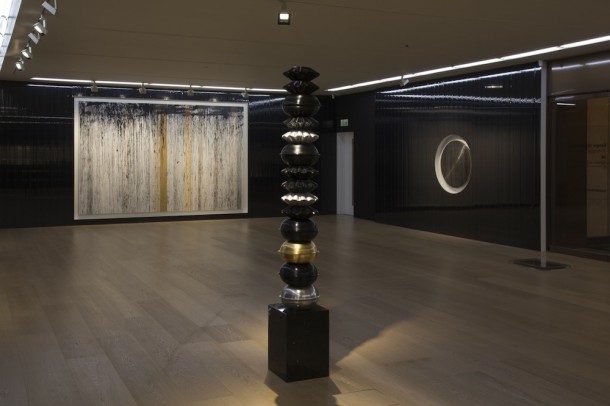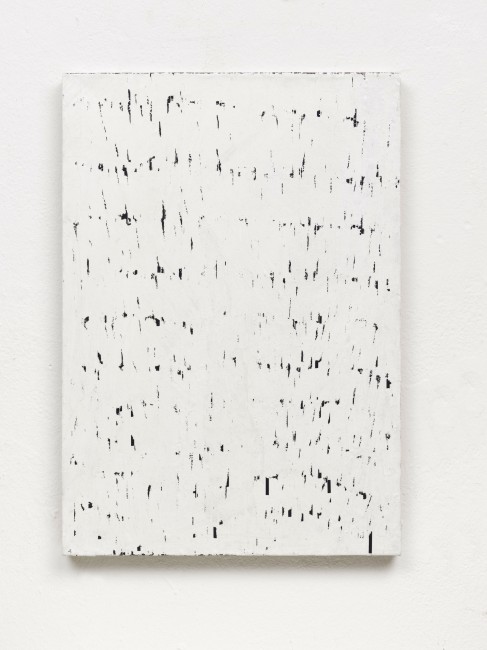A LOOK AT SOUNDS FROM THE PAST: GREGOR HILDEBRANDT
| April 21, 2015

Photo: Vincent Tsang
Courtesy Galerie Perrotin
WEB EXCLUSIVE
Gregor Hildebrandt (born 1974) is a German contemporary artist who lives and works in Berlin. Although Hildebrandt makes installations, sculptures, and works on canvas, his materials notably include, recording formats for sound and film, such as cassette tapes, videotapes, and vinyl records—archives of pop-cultural memories that contribute to identity formation. I was able to meet with Hildebrandt at Galerie Perrotin Hong Kong one day before the opening of his first solo exhibition in Asia, “Coming By Hazard.” We managed to have a casual chat as he installed the artworks with his assistants and other workers.
GREGOR HILDEBRANDT: This is the starting point of the show—my doormat in Berlin. It “came by hazard” to me—that is, by chance. It had belonged to the guy who had rented my flat before me, and I left it at the door. in the first time I was in Asia two years ago, it occurred to me that if I had the chance to have a show in Asia, i would return my doormat to its place of origin. A friend of mine told me, as I can’t read Chinese, that the words on the doormat mean “Come in peace/ Leave in peace” (出入平安). I think it’s a good slogan for entering a house, as well as an exhibition.
YIDI TSAO: Tell me a bit about the title of the exhibition—I tried but failed to translate it into Chinese.
GH: It comes from my bad English. I was with a friend at a restaurant in Berlin. Another friend passed by, and he asked me if I had arranged to meet up with her as well. I said, “no, she came by hazard.” My friend thought it was very poetic, whereas my sister, who speaks better English, said: “I’ve never heard that in English—you should say say that ‘she came by accident.’ But ‘coming by hazard’ is a great title. I think you should use it in a show. I’ll write the press release for you.”
Then I was sitting in my apartment looking at an etching from one of my mentors, Thomas Gruber. It was a gift, and I love it so much that I’ve hung it in all the apartments I’ve ever lived in. The association between “coming by hazard” and what’s written on the etching, “Le jeu de l’amour et du hasard (the game of love and chance)” made me want to do something for this show. I held the etching to a mirror and photographed its reflection: the work of the master work would be reflected in his student’s.

Cassette tape and acrylic paint on canvas, 57 x 40 cm
Courtesy Galerie Pretoria

Cassette tape and acrylic paint on canvas, 57 x 40 cm
Courtesy Galerie Perrotin
YT: Does each of your cassette paintings have one that mirrors it?
GH: Yeah, positive and negative twins. This painting in the corner isn’t part of the show. It’s a “bonus track,” in conversation with the painting opposite. Whereas one is entirely black, the other is white.
YT: Do people always collect them in pairs?
GH: Sometimes I sell them on the condition that they have to be together, but other times I also love the idea of one in Asia and the other in New York. Maybe one day I’ll propose to Emmanuel [Perrotin] that we simultaneously do one show here and one show in New York, with their contents reflecting each other.
YT: What about the bowl-shaped vinyl?
GH: I found it in 2003 at a flea market. It was like a bowl you could put potato chips in—I was impressed because it was literally “a bowl of music.” Take a look at what’s written there: “Today is the best day of my entire life.”
YT: And the colors?
GH: They’re both LaserDiscs, a home video format that came before VHS and DVD. The silver one has American Werewolf on it, and the gold one we brought to a specialist who gilded it for us. The idea came from Peter Marino, who inspired me with his columns.
YT: Is it easy to find these discs nowadays?
GH: They’ve actually stopped producing them.
YT: What if you run out of materials someday?
GH: I think when VHS and DVDs first came out, people were afraid movie theaters would eventually disappear—but cinema still exists, whereas video rental stores are dying out in favor of DVDs. People use BlueRay, but I don’t like them because I find them too sharp. I guess I’m from another generation.


